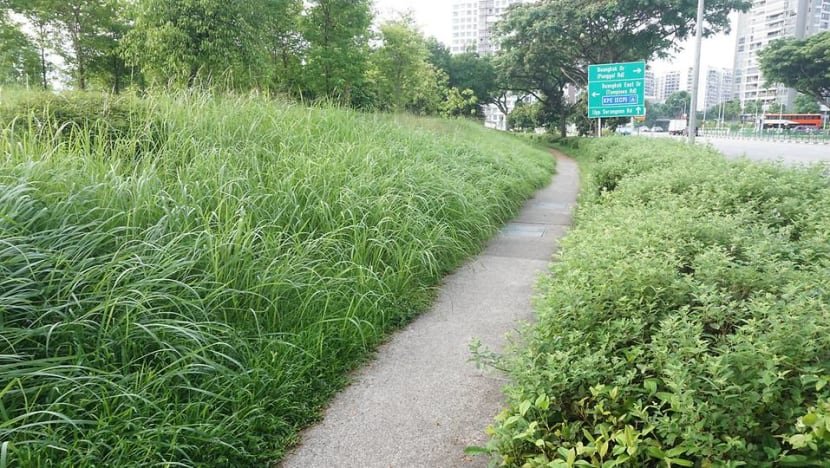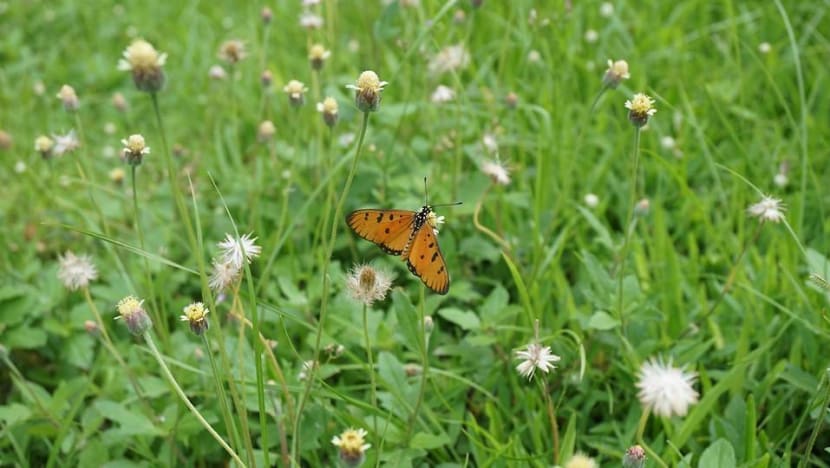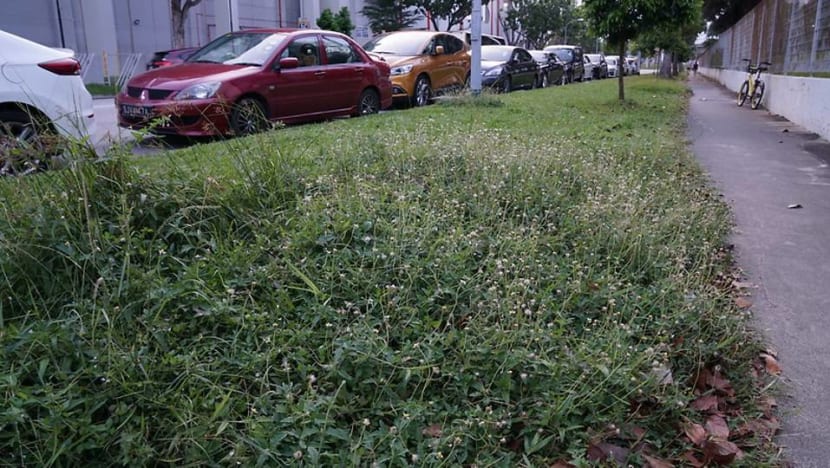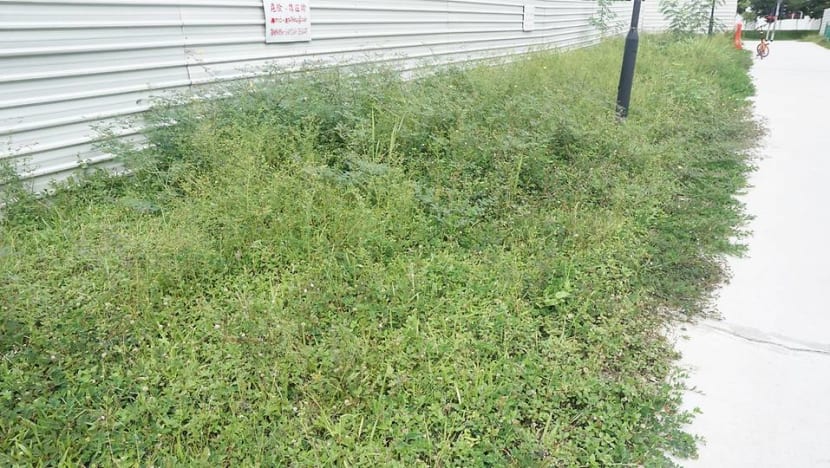commentary Commentary
Commentary: Let Singapore’s green spaces grow wild
COVID-19 has shown us how less manicured green spaces not only make Singapore more beautiful, but also more resilient, say Yun Hye Hwang and Sarah Ichioka.

(Photo: Seow Kang Ling)
SINGAPORE: One of the unexpected delights of the circuit breaker from Apr 7 to Jun 1 was the visible flourishing of natural life across Singapore, as grass-cutting and weeding activities ground to a halt.
In once closely mown grass patches, tropical wildflowers, forest shrub seedlings and native tree saplings sprang up. More butterflies, bees and birds were seen flitting about residential estates, roadsides and park connectors.
And people were enjoying the revitalised spaces too, judging from positive reactions on social media. Many netizens expressed appreciation for their beauty and diversity of plant and animal life. Some reminisced how these lush landscapes reminded them of Singapore in the 1960s and 70s.
READ: Commentary: The wonder of clear skies and returning wildlife is our new climate problem
On a practical level, some suggested that less manicured green spaces would reduce the air and noise pollution produced by gasoline-powered leaf blowers and mowers.
During a Jun 5 Parliament sitting, Nominated Member of Parliament Walter Theseira raised the point that less frequent maintenance could save public expenditure, lower manpower needs and improve biodiversity in Singapore.
The debate on whether we should let grass patches grow free makes us rethink our approach to managing the island’s greenery.
As urban strategists, we believe “renaturalising” – that is, allowing the spontaneous growth of plants in human-made spaces – can shape ecologically sustainable and healthy cities, and can be applied in Singapore.
READ: Commentary: Singapore’s dreams of becoming a solar-powered nation have almost arrived
THE BENEFITS OF RENATURALISING
In contrast to Singapore’s pre-COVID norm of buzz-cut lawns, renaturalised spaces support more varied and resilient ecosystems. The presence of diverse plants and their leaf litter help to improve soil quality and prevent erosion.
They also protect cities and their inhabitants from flash floods and heat – threats growing due to our global climate emergency. NUS’ Ventus garden, a 2,500 sq m renaturalised lawn, offers a positive example: After 18 months without cutting, its surface temperature was 4 degrees Celsius lower than surrounding lawns.
READ: Commentary: Rising temperatures, fires and floods highlight importance of understanding weather extremes

Less frequent grass-cutting can reduce petrol-intensive transport of landscape workers and the use of powered mowers and blowers, thereby reducing greenhouse gas emissions. Decreasing the man-hours currently spent on mowing, cultivating, transplanting and fertilising would also cut costs and save resources.
Many cities have come to embrace more naturalistic landscapes within their concrete jungles.
The design of the High Line in New York pays tribute to its history as an abandoned railway viaduct, with hundreds of plants that evoke the landscapes of woodlands and grasslands. Queen Elizabeth Olympic Park in London features colorful meadows of native wildflowers.
Both parks incorporate sustainable maintenance regimes which minimise intensive grass cutting and usage of chemical fertilisers and pesticides.
READ: Commentary: The truth behind returning wildlife is less feel-good than you think
However, letting Mother Nature flourish may be received with resistance by some Singaporeans who are accustomed to clean and tidy green verges.
Moreover, simply letting plants grow may not necessarily achieve greater biodiversity in the long run; fast-growing invasive species such as Mile-A-Minute vine and Lalang grass may aggressively overtake slow-growing native plants, as we can see in some urban scrubland areas with little variety of vegetation.
Agencies in turn may feel flustered by public complaints about mosquitoes breeding in concealed litter and other unwanted animals like snakes that might hide in tall grass. There are also safety concerns about tall grass posing a fire risk in dryer weather or blocking the view of traffic.
READ: Commentary: In Singapore, battling the COVID-19 threat outside and the dengue peril at home
NOT ZERO-MAINTENANCE
This is why it’s important to clarify that renaturalising the green spaces of Singapore wouldn’t mean letting them grow with zero-maintenance.
Instead, we believe Singapore can successfully transition many of its green spaces to a managed state of “naturalness”, balancing the ecological benefits of spontaneous plant growth and the need to preclude potential nuisances for residents.

Shifting to a renaturalising approach post-circuit breaker would help accelerate the National Parks Board’s 10-year City in Nature agenda, announced in March 2020.
Building upon Singapore’s many strengths in urban design and management, the agenda has goals such as restoring nature in the urban landscape, connecting green spaces to each other island-wide and advancing the landscape industry with science and technology.
In line with this new “City in Nature” vision, we imagine a phased process to renaturalise Singapore’s green spaces.
First, we should commence essential caretaking practices in place of indiscriminate mowing.
Maintenance activities would include regular cleaning of litter, removal of stagnant water sources to prevent mosquito breeding and tidying the edges of plots to ensure that pedestrian and vehicular traffic is not impeded.
READ: Commentary: How much will COVID-19 lockdowns slow the effects of climate change?
We should also assess those green spaces that grew wilder during the two month circuit breaker to see which are best suited for long-term renaturalising.
“In-between” stretches of turf not well-suited for other uses, like those bordering busy roads and car parks, are ideal. But spaces that exist for functional reasons such as sports fields will need closer manicuring, while green spaces around drains need frequent maintenance too lest they’re exposed to snakes and vermin.

Eventually, we can diversify the types and intensity of management activities depending on each site’s needs.
Take roadside greenery for example – we could reduce the frequency of grass cutting from biweekly to quarterly, and increasing cutting heights from 5cm to 30cm.
Green spaces in schools could be used as living labs. Commonwealth Secondary School, for instance, has cultivated gardens to resemble rainforests, wetlands and so on, for students to observe ecosystems and their inhabitants at work.
Further evolution could see schoolyards as sites for our next generation to regain traditional knowledge about edible and medicinal weeds. And our landscape workers can shift from control to care, observing and encouraging slower growing native species for example.
READ: Commentary: This new Ministry of Sustainability and Environment looks pretty promising
We believe that intentionally renaturalised urban greenery can become a vibrant new normal for Singapore. This approach would cultivate a living network of green spaces rich in plants and animals, to be explored and enjoyed by people from all walks of life.
Yun Hye Hwang is an Associate Professor at NUS, an accredited landscape architect and landscape researcher with expertise in socio-ecological design and management strategies that respond to emerging demands of high-density cities. Sarah Ichioka is an urbanist, curator and writer who leads Desire Lines, a strategic consultancy for environmental, cultural and social impact organisations and initiatives.













